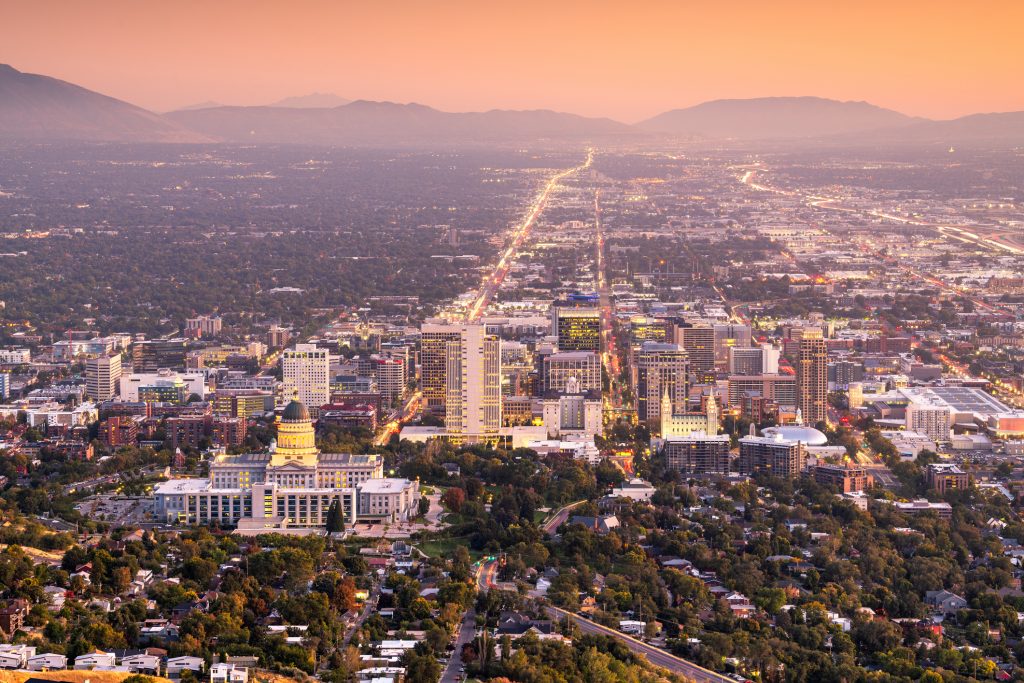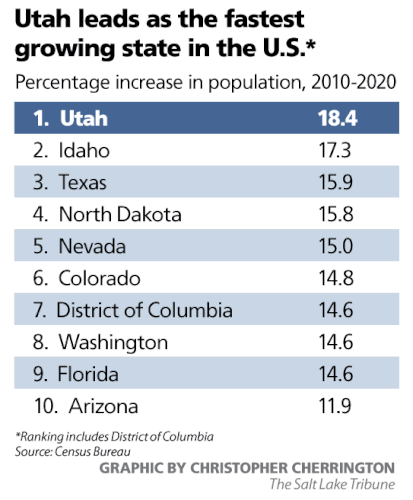New census numbers are staggering. We know Utah is growing.
See by how much and where.
Minorities now make up a quarter of the state’s population.

Utah is in the middle of a historic population boom, and new census numbers released Thursday make it clear no state is transforming at a faster clip.
Its nation-leading population spurt has spurred an impressive rise in new housing. Utah remains the nation’s youngest state and yet it saw the fastest growth in residents 18 and older. Its population is diversifying, particularly in metro areas where the state saw a jump in its Hispanic population.
The Census Bureau released this 2020 data Thursday to help states create new political districts as required by the Constitution, but these numbers also tell a story of a nation that is growing older and less white, and where the West is rising.
The U.S. population now stands at 331,449,281, up 7.4% from 2010 — its second lowest rise in 10 years since the 1930s.
We’re No. 1

Utah added half a million new residents between 2010 and 2020, a combination of people moving here and Utahns having children. That’s an 18.4% growth rate, the fastest in the nation.
And it wasn’t particularly close.
Idaho came in second at 17.3%, followed by Texas (15.9%), North Dakota (15.8%) and Nevada (15%).
Three states lost population. They are West Virginia (minus 3.2%), Mississippi (down 0.2%) and Illinois (minus 0.1%).
Utah now has 3,271,616 million residents.
The population explosion was centered in the metro areas in the north, led by Wasatch County’s eye-popping 47.8% leap in the past decade. Followed, in the south, by Washington County, which grew by 30%.
Salt Lake County’s population rose by 155,583 people to 1,185,238. That’s a 15.1% jump.
Utah County, the state’s second most populous, added 142,835 residents, growing to 659,399. That’s a 27.7% increase in 10 years.
Davis County is now at 362,679, up 18.3% from a decade ago, and Weber County has 262,223 residents, 15.4% more than it did in 2010.
Staying younger
While nobody is getting any younger, Utah is still out in front as the nation’s most youthful state.
The effect of aging baby boomers — folks between 57 and 75 as of 2021 — combined with steady declines in the U.S. fertility rate over the past decade to make the country older as a whole.
U.S. residents ages 18 and over made up 74.3% of the total population in 2000 and 76% in 2010, and with this first detailed look at census trends for 2020, that share has pushed to 77.9%.
That aging effect came against a backdrop of slowing population growth overall between 2010 and 2020. And even though rapidly growing Utah saw the biggest leap of all states in its adult population since 2010 — up 22.8% over the decade — the state still ranks as the country’s youngest, with its share of those over 18 at 71%.
The next youngest state, Idaho, is at 74.8% ages 18 or older.
Diversity keeps growing
Utah remains one of the whiter states in the nation. Most states saw its “white, not Hispanic” population decline, but 15 states saw an increase and none topped Utah’s 11%. The District of Columbia did beat Utah, though, seeing its white population swell by 25%.
Still, Utah marked a significant increase in racial and ethnic diversity. In 2010, 19.6% of residents were minorities. In 2020, that rose to nearly a quarter (24.6%). This growth happened during Utah’s nation-leading population surge.
In Salt Lake County, the state’s most populous, the percentage of residents who are minorities went from 26% in 2010 to 32.4% in 2020.
Hispanics make up Utah’s biggest minority group. They account for 15.1% of the state’s population and 19.6% of Salt Lake County residents. The second largest minority group is people who identify as two or more races, not Hispanic. That is 3.7% of Utah’s population. After that, it is Asian at 2.4% and then Black and Pacific Islanders tied at 1.1%.
More housing, still not enough
The pace of U.S. housing construction slowed between 2010 and 2020 compared to the decade before, but, again, Utah’s population growth bucked that trend.
Housing units grew by 6.7% for the country as a whole, a growth rate dampened by hangover effects of a mid-2000s homebuilding boom followed by the market crash that led to the Great Recession and an oversupply of housing.
But the West and South regions saw homes go up much faster as they grew, and Utah saw its housing stock surge by 17.5% — nearly triple the national increase.
The state now has 1.15 million single-family homes, town homes, apartments and mobile homes, the census shows, as well as recreational vehicles, vans, houseboats and other nontraditional housing units.
Despite that growth, housing analysts estimate Utah still lacks more than 50,000 rentals and homes for sale even as homebuilders add units at a historic pace — a gap made worse by the pandemic.
Washington, D.C., saw its housing stock grow the fastest over the past decade, up 18.1%, followed by Utah, North Dakota (16.7%) and Texas (16.2%).



